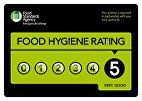Top Tips for Safe Internet Use for Children Aged 0-5
Top Tips for Safe Internet Use for Children Aged 0-5

Section 1: Understanding Online Safety
Ensuring your child's online safety is crucial in today's digital world. Here’s how you can create a secure environment for your young ones.
The Importance of Online Safety
Online safety for children aged 0-5 is of paramount importance because they are highly vulnerable to the dangers lurking on the internet. At this age, children are curious and tend to explore the digital world without understanding the potential risks. It is crucial to shield them from inappropriate content, cyberbullying, and online predators to ensure their mental and emotional well-being.
Common Online Threats
Young children can easily stumble upon inappropriate content that can be disturbing or harmful. They are also at risk of encountering cyberbullies who might exploit their innocence. Online predators pose a serious threat as well, often using deceptive tactics to lure children into dangerous situations. Understanding these threats helps parents take proactive measures to protect their children.
Building a Safe Environment
Creating a safe digital environment involves setting up robust parental controls, educating children about the basics of online safety, and maintaining open communication. Use child-friendly search engines and apps designed for young kids. Always supervise their online activities and encourage them to talk to you about anything they find confusing or uncomfortable.
Section 2: Locking Devices
Protecting your devices is the first line of defence in ensuring your child's online safety.
Setting Up Parental Controls
Parental controls are essential tools that allow you to restrict access to inappropriate content and monitor your child's online activities. Most devices, including smartphones, tablets, and computers, have built-in parental control settings. Take the time to configure these settings according to your child’s age and maturity level. You can block certain websites, limit screen time, and even monitor the apps your child is using.
For instance, you might set up controls to restrict access to specific websites known for adult content or limit screen time to one hour per day. This ensures that your child is exposed only to age-appropriate material while also helping you manage their internet usage effectively.
Password Protection
Ensure all devices have strong passwords that your child cannot easily guess. Change passwords regularly and avoid using easily guessable information, such as birthdays or pet names. It’s also wise to use a combination of letters, numbers, and symbols to create a robust password. This helps in preventing unauthorized access and protects sensitive information.
A practical example would be setting up a password with a mix of uppercase and lowercase letters, numbers, and special characters, like "P@ssw0rd123!". This type of password is difficult for a child to guess and adds an extra layer of security.
Monitoring Usage
Regularly monitor your child's internet usage to stay informed about the websites and apps they are accessing. There are various monitoring tools and apps available that provide detailed reports on your child's online activity. This helps you identify any potential risks early and take necessary actions to mitigate them. Encourage your child to use the internet in a common area of the house where you can easily keep an eye on their activities.
Section 3: Safe Use of Social Media
While social media is generally not suitable for very young children, it's important to understand the basics in case your child is exposed to it.
Age Restrictions
Most social media platforms require users to be at least 13 years old. Explain to your child why these age restrictions exist and the importance of waiting until they are older to join social media. Emphasize that these rules are in place to protect them from inappropriate content and interactions.
Supervised Interaction
If your child does engage with social media, ensure their interactions are closely monitored. Set up accounts with strict privacy settings and regularly check their friends' lists and interactions. Teach them to be cautious about accepting friend requests from people they don't know in real life and to report any suspicious or uncomfortable behaviour.
Practical steps include:
- Using privacy settings to limit who can see your child's posts.
- Reviewing your child’s friend list regularly to ensure they only interact with known individuals.
- Encouraging your child to tell you immediately if they encounter something that makes them uncomfortable online.
Educating About Privacy
Educate your child about the importance of keeping personal information private. Explain that they should never share details like their full name, address, phone number, or school name online. Teach them to recognise and avoid phishing attempts and scams that ask for personal information.
Key points to discuss with your child include:
- Never sharing passwords with friends.
- Understanding that once something is posted online, it can be difficult to remove completely.
- Recognising and avoiding online strangers who ask for personal information.
By having regular conversations about these topics, you can help your child develop a healthy understanding of online privacy and safety.
Section 4: Age-Appropriate Apps and Content
Choosing the right digital content is essential for your child's safety and development.
Choosing the Right Apps
Select apps that are specifically designed for young children and have been reviewed for safety and educational value. Look for apps that offer engaging and interactive content that is appropriate for your child’s age. Websites like Common Sense Media can provide reliable reviews and recommendations for apps, games, and other digital content.
For example, you might choose educational apps like "ABCmouse" or "Endless Alphabet," which are designed to help children learn in a fun and interactive way. These apps often include features that allow parents to monitor progress and set usage limits.
Educational Benefits
Many apps offer educational benefits, such as teaching basic literacy and numeracy skills, promoting creativity, and enhancing problem-solving abilities. While these apps can be beneficial, it's important to ensure they are balanced with offline activities. Encourage your child to engage in physical play, reading, and other non-digital activities.
A practical example would be setting aside specific times for app usage, such as 30 minutes in the morning and 30 minutes in the afternoon, while also ensuring your child spends time playing outside or engaging in hands-on activities like building blocks or drawing.
Content Reviews
Before downloading an app or allowing your child to watch a video, take the time to read reviews and ratings. Trusted sources like Common Sense Media offer detailed reviews and age ratings for various digital content. This can help you make informed decisions about what is suitable for your child.
Recommended resources include:
- Common Sense Media: Provides age-based ratings and reviews for apps, games, and media.
- Kidslox: Offers detailed reviews and parental controls for various digital content.
- The Toy Insider: Recommends age-appropriate tech toys and apps.
Using these resources helps ensure that your child is exposed to safe and beneficial digital content, making their online experiences both educational and enjoyable.
Section 5: Restricting Use and Setting Boundaries
Setting clear rules and boundaries around internet use helps create a healthy balance.
Creating a Schedule
Establish a consistent schedule for internet use to manage your child's screen time effectively. For children aged 0-5, it is recommended to limit screen time to no more than one hour per day of high-quality programming. Create a routine that includes time for educational apps, free play, and family activities.
A practical approach might involve setting specific times during the day when your child can use digital devices, such as 30 minutes in the morning and 30 minutes in the evening. Consistency in this schedule helps children understand the boundaries and develop healthy habits around screen time.
Offline Activities
Encourage a healthy balance between online and offline activities. Promote physical play, reading, arts and crafts, and other non-digital activities to ensure your child’s overall development. Physical activity is crucial for young children’s growth and health, so make sure they spend ample time playing outdoors.
For example, you could create a daily routine that includes outdoor playtime in the backyard or a local park, reading sessions with picture books, and creative activities like drawing or building with blocks. This variety ensures that your child develops a range of skills and interests.
Leading by Example
As a parent, you can set a positive example by demonstrating good online habits and responsible internet use. Show your child that you prioritize offline activities and use the internet in a balanced way. Your behavior will influence how they perceive and use digital devices.
A practical example includes putting away your phone during family meals and engaging in activities like reading a book or playing a board game together. By showing that you value these activities, you help instill similar values in your child.
Conclusion
By following these practical tips, you can help ensure that your young children have a safe and positive experience online. Stay informed, stay involved, and create a secure digital environment for your little ones. Remember, your guidance and supervision are key to protecting them in the digital world. Here’s a quick recap of the essential points covered in this guide:
1. Understanding Online Safety: Educate yourself and your children about the importance of online safety and the common threats they may encounter.
2. Locking Devices: Use parental controls and strong passwords to protect your devices and monitor your child’s internet usage.
3. Safe Use of Social Media: Explain age restrictions, supervise interactions, and educate your child about the importance of privacy.
4. Age-Appropriate Apps and Content: Choose apps that are safe and educational, and ensure a healthy balance between online and offline activities.
5. Restricting Use and Setting Boundaries: Establish a consistent schedule for internet use, encourage offline activities, and lead by example.
FAQ
Q1: How can I monitor my child's online activity without invading their privacy?
A1: Use parental control apps that offer a balance between monitoring and privacy. Tools like Qustodio, Norton Family, and Bark provide detailed reports on online activities while respecting privacy boundaries. Explain to your children why monitoring is necessary for their safety and keep the communication open, so they feel comfortable discussing their online experiences with you.
Q2: What should I do if my child encounters inappropriate content?
A2: Stay calm and discuss the content with your child. Use this as an opportunity to teach them about safe internet use and how to handle such situations. Encourage them to tell you about anything that makes them uncomfortable. Block and report the inappropriate content to prevent further exposure.
Q3: Are there any trusted sources for app reviews?
A3: Websites like Common Sense Media provide detailed reviews and age ratings for various apps, games, and media content. These reviews help parents make informed decisions about what is suitable for their children. Additionally, SafeWise and Childnet offer resources and guidelines on selecting safe and educational digital content.
Q4: How much screen time is appropriate for children aged 0-5?
A4: The American Academy of Pediatrics recommends no screen time for children under 18 months, except for video chatting. For children aged 2-5, limit screen time to one hour per day of high-quality programming. Ensure that screen time does not interfere with sleep, physical activity, and other essential behaviors for health.
Q5: How can I ensure my child understands the importance of online safety?
A5: Regularly communicate with your child about online safety. Use age-appropriate language and examples to explain the importance of staying safe online. Encourage your child to ask questions and express any concerns. Role-playing different scenarios can help reinforce these lessons. Keeping an open dialogue helps children feel secure and informed about their online activities.
By implementing these tips and staying updated with the latest guidelines and tools, you can help ensure your child's online safety effectively.
GLOBAL KIDS DAY CARE LIMEHOUSE
Lascar Wharf Community Centre, Limehouse, London, E14 7FN. | Tel: 0207 001 1210 Email: limehouse@globalkidsdaycare.co.uk
GLOBAL KIDS DAY CARE MILE END
21 Burdett Road, Mile End, London, E3 4TU. | Tel: 0208 980 1706 Email: mile-end@globalkidsdaycare.co.uk
GLOBAL KIDS DAY CARE ALDGATE EAST
52 Old Castle Street, Aldgate East, London E1 7AJ. | Tel: 0203 302 7800 / Mobile: 07823 770035 | Email: aldgateeast@globalkidsdaycare.co.uk
Opening Times: 8am - 6pm

















